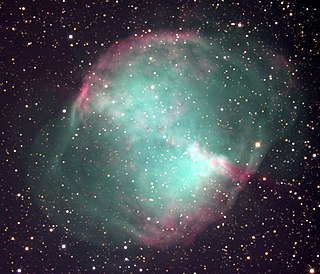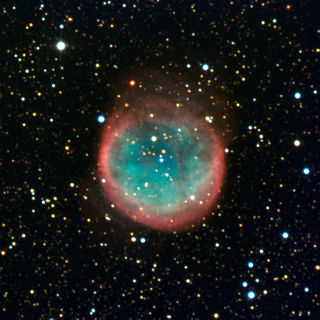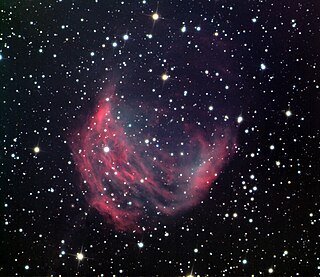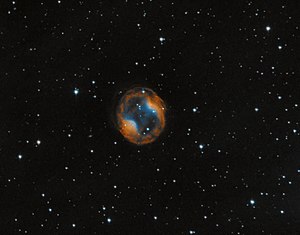
Cygnus is a northern constellation on the plane of the Milky Way, deriving its name from the Latinized Greek word for swan. Cygnus is one of the most recognizable constellations of the northern summer and autumn, and it features a prominent asterism known as the Northern Cross. Cygnus was among the 48 constellations listed by the 2nd century astronomer Ptolemy, and it remains one of the 88 modern constellations.

A nebula is a distinct luminescent part of interstellar medium, which can consist of ionized, neutral, or molecular hydrogen and also cosmic dust. Nebulae are often star-forming regions, such as in the Pillars of Creation in the Eagle Nebula. In these regions, the formations of gas, dust, and other materials "clump" together to form denser regions, which attract further matter and eventually become dense enough to form stars. The remaining material is then thought to form planets and other planetary system objects.

Sagittarius is one of the constellations of the zodiac and is located in the Southern celestial hemisphere. It is one of the 48 constellations listed by the 2nd-century astronomer Ptolemy and remains one of the 88 modern constellations. Its old astronomical symbol is (♐︎). Its name is Latin for "archer". Sagittarius is commonly represented as a centaur drawing a bow. It lies between Scorpius and Ophiuchus to the west and Capricornus and Microscopium to the east.

A planetary nebula is a type of emission nebula consisting of an expanding, glowing shell of ionized gas ejected from red giant stars late in their lives.

The Ring Nebula is a planetary nebula in the northern constellation of Lyra.[C] Such a nebula is formed when a star, during the last stages of its evolution before becoming a white dwarf, expels a vast luminous envelope of ionized gas into the surrounding interstellar space.

The Dumbbell Nebula is a planetary nebula in the constellation Vulpecula, at a distance of about 1360 light-years. It was the first such nebula to be discovered, by Charles Messier in 1764. At its brightness of visual magnitude 7.5 and diameter of about 8 arcminutes, it is easily visible in binoculars and is a popular observing target in amateur telescopes.

The Eskimo Nebula, also known as the Clown-faced Nebula, Lion Nebula, or Caldwell 39, is a bipolar double-shell planetary nebula (PN). It was discovered by astronomer William Herschel in 1787. The formation resembles a person's head surrounded by a parka hood. It is surrounded by gas that composed the outer layers of a Sun-like star. The visible inner filaments are ejected by a strong wind of particles from the central star. The outer disk contains unusual, light-year-long filaments.

Luboš Kohoutek was a Czech astronomer and a discoverer of minor planets and comets, including Comet Kohoutek which was visible to the naked eye in 1973. He also discovered a large number of planetary nebulae.

The Little Dumbbell Nebula, also known as Messier 76, NGC 650/651, the Barbell Nebula, or the Cork Nebula, is a planetary nebula in the northern constellation of Perseus. It was discovered by Pierre Méchain in 1780 and included in Charles Messier's catalog of comet-like objects as number 76. It was first classified as a planetary nebula in 1918 by the astronomer Heber Doust Curtis. However, others might have previously recognized it as a planetary nebula; for example, William Huggins found its spectrum indicated it was a nebula ; and Isaac Roberts in 1891 suggested that M76 might be similar to the Ring Nebula (M57), as seen instead from the side view.

The Owl Nebula is a planetary nebula approximately 2,030 light years away in the constellation Ursa Major. Estimated to be about 8,000 years old, it is approximately circular in cross-section with a faint internal structure. It was formed from the outflow of material from the stellar wind of the central star as it evolved along the asymptotic giant branch. The nebula is arranged in three concentric shells, with the outermost shell being about 20–30% larger than the inner shell. The owl-like appearance of the nebula is the result of an inner shell that is not circularly symmetric, but instead forms a barrel-like structure aligned at an angle of 45° to the line of sight.

NGC 6781, also known as the Snowglobe Nebula, is a planetary nebula located in the equatorial constellation of Aquila, about 2.5° east-northeast of the 5th magnitude star 19 Aquilae. It was discovered July 30, 1788 by the Anglo-German astronomer William Herschel. The nebula lies at a distance of 1,500 ly from the Sun. It has a visual magnitude of 11.4 and spans an angular size of 1.9 × 1.8 arcminutes.

The Medusa Nebula is a planetary nebula in the constellation of Gemini. It is also known as Abell 21 and Sharpless 2-274. It was originally discovered in 1955 by University of California, Los Angeles astronomer George O. Abell, who classified it as an old planetary nebula. With the computation of expansion velocities and the thermal character of the radio emission, Soviet astronomers in 1971 concluded that it was most likely a planetary nebula. As the nebula is so large, its surface brightness is very low, with surface magnitudes of between +15.99 and +25 reported.

NGC 3195 is a planetary nebula located in the southern constellation of Chamaeleon. Discovered by Sir John Herschel in 1835, this 11.6 apparent magnitude planetary nebula is slightly oval in shape, with dimensions of 40×35 arc seconds, and can be seen visually in telescopic apertures of 10.5 centimetres (4.1 in) at low magnifications.

Luboš Perek was a Czech astronomer best known for his Catalogue of Galactic Planetary Nebulae co-written in 1967 with Luboš Kohoutek. He worked on the distribution of mass in the galaxy, high-velocity stars, planetary nebulae, definition of outer space, geostationary orbit, space debris, and management of outer space.

NGC 2899 is a planetary nebula in the southern constellation of Vela. It was discovered by English astronomer John Herschel on February 27, 1835. This nebula can be viewed with a moderate-sized amateur telescope, but requires a larger telescope to resolve details. NGC 2899 is located at a distance of 3,350 ± 670 light-years (1,026 ± 205 pc) from the Sun and 25,894 ± 3 light-years (7,939 ± 1 pc) from the Galactic Center.

The Abell Catalog of Planetary Nebulae was created in 1966 by George O. Abell and was composed of 86 entries thought to be planetary nebulae that were collected from discoveries, about half by Albert George Wilson and the rest by Abell, Robert George Harrington, and Rudolph Minkowski. All were discovered before August 1955 as part of the National Geographic Society – Palomar Observatory Sky Survey on photographic plates created with the 48-inch (1.2 m) Samuel Oschin telescope at Mount Palomar. Four are better known from previous catalogs: Abell 50 is NGC 6742, Abell 75 is NGC 7076, Abell 37 is IC 972, and Abell 81 is IC 1454. Another four were later rejected as not being planetaries: Abell 11, Abell 32, Abell 76, and Abell 85. Another three were also not included in the Strasbourg-ESO Catalogue of Galactic Planetary Nebulae (SEC): Abell 9, Abell 17, and Abell 64. Planetaries on the list are best viewed with a large aperture telescope and an OIII filter.
K1-2 is a planetary nebula in the constellation Pyxis. It was discovered by Czech astronomer Luboš Kohoutek in 1961. The central star of the nebula—VW Pyxidis—is a post-common-envelope binary composed of a hot degenerate star and a cooler companion in a close orbit. A best-fit calculation from its orbit and spectra yields a white dwarf-like star with around 50% of the Sun's mass and a main sequence lie star around 70% as massive as the Sun. Jets of matter are emanating from the system. One study yielded a surface temperature of 85,000 K for the hotter star.

KjPn 8 is a bipolar planetary nebula which was discovered by M.A. Kazaryan and Eh. S. Parsamyan in 1971 and independently by Luboš Kohoutek in 1972.



















